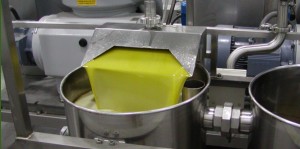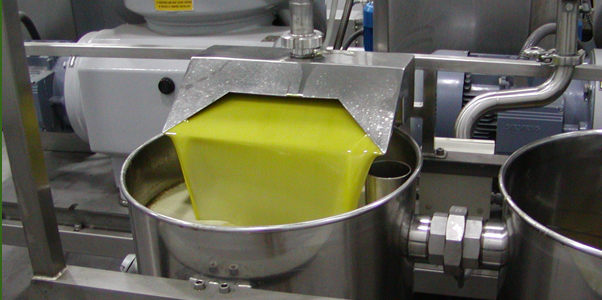 Any American olive oil consumer who has been paying attention to the news in recent months is probably reeling. The announcement last April that the U.S. Department of Agriculture (USDA) was adopting standards for olive oil was the first eye-opener. This was the first time many consumers realized that there had been no definition in the U.S. for the term “extra virgin.”
Any American olive oil consumer who has been paying attention to the news in recent months is probably reeling. The announcement last April that the U.S. Department of Agriculture (USDA) was adopting standards for olive oil was the first eye-opener. This was the first time many consumers realized that there had been no definition in the U.S. for the term “extra virgin.”
Then came the report on supermarket olive oils from the University of California, Davis: 69 percent of imported olive oil samples and 10 percent of California olive oil samples labeled as extra virgin failed to meet the International Olive Council (IOC)/USDA sensory standards. That’s when the shouting really started. Press releases flew back and forth, attacking and defending the study. Lawsuits were filed on behalf of consumers and chefs, alleging mislabeling and fraud. The blogosphere exploded with discussion about free fatty acid levels, diacylglycerols and truth in labeling. The battle was on.
Low-quality olive oil labeled as extra virgin in American markets is not a new problem. In addition to the maximum free fatty acid level and other chemical standards, the IOC (and now the USDA) definition of extra virgin includes a sensory standard: the oil cannot have any sensory defects and must have some olive fruitiness. So no matter what the chemical analyses say, if an oil tastes of fermented olives or advanced oxidation, it isn’t extra virgin. And despite the outraged denials from some sectors of the olive oil industry, any trained olive oil taster can tell you that in years past when we wanted samples of “fusty” or “rancid” defects, we just went to our local supermarket and grabbed a few bottles of familiar name brand oils off the shelf.
Although the process has been messy, and the tone often strident, there is an upside to all this fuss: American consumers are talking about olive oil quality. My fear is that, in all this sound and fury, many misconceptions are setting in among consumers. Among the many I’ve heard in the last few months are these three misguided conclusions:
Wrong conclusion No. 1: The industry is so messed up, I’ll just stop using olive oil.
It’s true that the industry has its dark side and some extremely dysfunctional moments, but olive oil is still a wonderful part of a healthy diet and belongs on your table every day. Americans would benefit from using more olive oil, not less. It is the industry’s job to clean up its act and give the consumer truthful labeling. A proposed standard in Australia, for example, would require that products containing refined olive oil must make that distinction on their label.
Most consumers don’t realize that “extra light” and “pure olive oil” are blends of refined olive oil with only a little virgin olive oil. Under the draft Australian standards, these product labels would have to say “refined olive oil blend.” A regulation like that here would go a long way towards giving American consumers some real information about what they are buying.
Wrong conclusion No. 2: All imported oil is bad.
This is utter nonsense. There are excellent oils being made by ethical producers all over the world. If there is an Us and a Them in this debate, the lines are not drawn along national borders. The line is between the honest producers of real extra virgin olive oil — passionate and dedicated people who make the olive oil you want on your table — and the packagers and industrial producers who care only for profit and will game the system any which way to get the most money out of it.
Wrong conclusion No. 3: The new USDA standards will take care of the problem.
Wishful thinking. The new standards are a big step in the right direction, but they are far from a cure-all. For openers, the standard is voluntary, and it is for “U.S. extra virgin,” not for “extra virgin.” This standard can be applied to olive oil produced in the United States or to imports, but is a voluntary certification in either case. So unless it says “U.S. extra virgin” on the label and has the USDA certification shield, it is not certified under the USDA standard. For the full rundown, see the report Understanding USDA Olive Oil Standards.
The realization that the American market has been a dumping ground for inaccurately labeled, low-quality olive oil for years is giving rise to a lot of well-founded indignation. But American consumers need to recognize their power in this situation. Why is there so much excitement and agitation over olive oil standards? Because the U.S. market for olive oil is enormous, and when consumers start insisting on quality, they will be heard.
Well-crafted and well-enforced quality standards for olive oil are essential, and we need to keep pushing that agenda. It is unfair — to both the good producer and the consumer — that meticulously produced, fresh, true extra virgin olive oils must compete with cheap, poorly made, old, blended, even adulterated products with identical labeling. But the regulatory road is a long and expensive one; we need an interim plan.
If American consumers educate themselves about olive oil, they can make better decisions in the market – and that will be felt quickly in the industry. I would encourage anyone concerned about food quality to taste good olive oil: fresh, high-quality olive oil is a revelation after all that old, tired, generic junk.
Personally, I buy primarily local California olive oil, as well as some estate-produced oils from overseas. Over the years, I have found producers whose quality and integrity I trust. There are also some certification programs out there that can help steer consumers to good olive oil. There is a summary of some of these programs at the end of Understanding USDA Olive Oil Standards. Awards from reputable competitions can be a good indicator as well, including the Mario Solinas, Los Angeles International Extra Virgin Olive Oil Competition, Yolo County Fair and various competitions in New Zealand and Australia.
Enthusiasts also can read up. Unfortunately, the amount of misinformation out there in books and online, particularly on e-commerce sites, is staggering, so casting a skeptical eye is advisable. That said, there are many good sources, starting with Olive Oil Times, which has taken the lead among English-language sites in reporting on industry news.
Despite recent scandals, more high-quality olive oil is available now than ever before. The fact that American consumers are even discussing olive oil quality is in itself a tremendous victory for honest producers. I hope that this debate will further embolden the champions of transparency and quality; the time is ripe for even more significant reform.
This editorial originally appeared in January 2011 in the Soapbox section at www.zesterdaily.com

I’m sincerely interested in knowing scam from authentic. After significant research, I still don’t know whit from shinola. I’d love to find a simple list of reputable purveyors. I can’t make consumer choices on the idea that the more expensive the better.
Thank you, Bruce, for your comment. I completely understand the trepidation about buying simply based on price; a high price is no guarantee of excellence. But you can be pretty sure that a really low price is a bad sign. I put a few trusted purveyors who do mail order on the olive oil appreciation page; you can order from them with confidence. Tom Mueller has a much more extensive list of producers and retailers on the Extra Virginity website as well. The availability of good honest olive oil in your community will, of course, depend on where you live, but here’s a simple recommendation for getting a taste of fresh evoo from a regular market: look for one of the big, widely-distributed brands from California or Australia (I think Corto Olive, California Olive Ranch and Cobram Estate are the three you are most likely to see). Be sure to check the “best by” date or harvest date. You want to find an oil from the current harvest (fall of 2011 for California, spring of 2011 for Australia). All of those brands are great starter oils when you are looking for something affordable but still fresh and reliably real extra virgin. There are, of course, great oils from all over, but those are three reliable brands I see in wide distribution. Try one and see what you think!